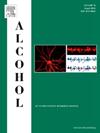Intermittent short- and long-term alcohol exposures influence alcohol consumption, anxiety-like behaviors, and seizure onset in genetically epilepsy-prone rats
IF 2.9
4区 医学
Q3 PHARMACOLOGY & PHARMACY
引用次数: 0
Abstract
The genetically epilepsy-prone rats (GEPR-3s) are known for their hereditary susceptibility to seizures and anxiety. This study investigates the impact of short-term (1 week) and long-term (4 weeks) intermittent alcohol exposure through a two-bottle choice paradigm on voluntary alcohol intake, anxiety-like behaviors, and acoustically evoked seizure susceptibility in the GEPR-3s. Anxiety behaviors were assessed 24 h post alcohol exposure using the light-dark box (LDB), open field (OFT), and elevated plus maze (EPM), alongside evaluations of seizure susceptibility. The results indicated that after 1 week of alcohol exposure, female GEPR-3s had higher alcohol intake and preference than males, while males increased their intake and preference after 4 weeks. Furthermore, females GEPR-3s exhibited anxiolytic effects in all anxiety tests after short-term alcohol exposure. In contrast, males displayed mixed responses, exhibiting anxiogenic effects in both LDB and OFT tests, and increased time in open arms but decreased exploration in the EPM test. Further, short-term alcohol exposure delayed seizure onset across both sexes, suggesting potential anticonvulsant effects. After 4 weeks of alcohol exposure, male GEPR-3s exhibited anxiogenic effects in both LDB and OFT tests, and reduced locomotion in the EPM test. In contrast, female GEPR-3ss showed anxiogenic effects in the LDB test, but anxiolytic effects in the OFT test, with decreased locomotion in the EPM test. Additionally, long-term alcohol exposure decreased seizure latency, indicating proconvulsant effects. These findings highlight the complex, bidirectional, and temporal dynamics between alcohol consumption, anxiety, and inherited predisposition to epilepsy.
间歇性短期和长期酒精暴露会影响遗传性癫痫易感大鼠的酒精消耗、焦虑样行为和癫痫发作。
遗传性癫痫易感性大鼠(GEPR-3s)因其对癫痫发作和焦虑的遗传易感性而闻名。本研究通过两瓶选择范式探讨了短期(1周)和长期(4周)间歇性酒精暴露对GEPR-3s患者自愿饮酒、焦虑样行为和声诱发癫痫易感性的影响。使用光暗箱(LDB)、开放场地(OFT)和升高迷宫(EPM)评估酒精暴露后24小时的焦虑行为,同时评估癫痫易感性。结果表明,酒精暴露1周后,女性GEPR-3s的酒精摄入量和偏好高于男性,而男性的酒精摄入量和偏好在4周后增加。此外,短期酒精暴露后,女性GEPR-3s在所有焦虑测试中均表现出抗焦虑作用。相比之下,男性表现出不同的反应,在LDB和OFT测试中都表现出焦虑效应,在张开双臂的时间增加,但在EPM测试中探索的时间减少。此外,短期酒精暴露延迟了两性癫痫发作,提示潜在的抗惊厥作用。酒精暴露4周后,男性GEPR-3s在LDB和OFT测试中都表现出焦虑效应,在EPM测试中表现出运动能力下降。相比之下,女性GEPR-3ss在LDB测试中表现出焦虑作用,但在OFT测试中表现出焦虑作用,在EPM测试中表现出运动减少。此外,长期酒精暴露减少了癫痫发作潜伏期,表明有前惊厥作用。这些发现强调了饮酒、焦虑和癫痫遗传易感性之间复杂的、双向的和时间的动态关系。
本文章由计算机程序翻译,如有差异,请以英文原文为准。
求助全文
约1分钟内获得全文
求助全文
来源期刊

Alcohol
医学-毒理学
CiteScore
4.60
自引率
4.30%
发文量
74
审稿时长
15.6 weeks
期刊介绍:
Alcohol is an international, peer-reviewed journal that is devoted to publishing multi-disciplinary biomedical research on all aspects of the actions or effects of alcohol on the nervous system or on other organ systems. Emphasis is given to studies into the causes and consequences of alcohol abuse and alcoholism, and biomedical aspects of diagnosis, etiology, treatment or prevention of alcohol-related health effects.
Intended for both research scientists and practicing clinicians, the journal publishes original research on the neurobiological, neurobehavioral, and pathophysiological processes associated with alcohol drinking, alcohol abuse, alcohol-seeking behavior, tolerance, dependence, withdrawal, protracted abstinence, and relapse. In addition, the journal reports studies on the effects alcohol on brain mechanisms of neuroplasticity over the life span, biological factors associated with adolescent alcohol abuse, pharmacotherapeutic strategies in the treatment of alcoholism, biological and biochemical markers of alcohol abuse and alcoholism, pathological effects of uncontrolled drinking, biomedical and molecular factors in the effects on liver, immune system, and other organ systems, and biomedical aspects of fetal alcohol spectrum disorder including mechanisms of damage, diagnosis and early detection, treatment, and prevention. Articles are published from all levels of biomedical inquiry, including the following: molecular and cellular studies of alcohol''s actions in vitro and in vivo; animal model studies of genetic, pharmacological, behavioral, developmental or pathophysiological aspects of alcohol; human studies of genetic, behavioral, cognitive, neuroimaging, or pathological aspects of alcohol drinking; clinical studies of diagnosis (including dual diagnosis), treatment, prevention, and epidemiology. The journal will publish 9 issues per year; the accepted abbreviation for Alcohol for bibliographic citation is Alcohol.
 求助内容:
求助内容: 应助结果提醒方式:
应助结果提醒方式:


